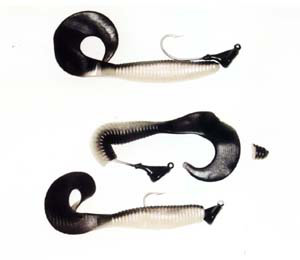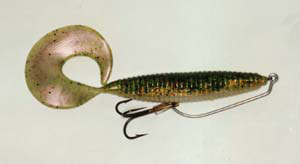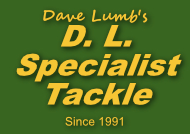There
is a boom in the fishing of soft plastics for pike at the present. I have one
article on the net about this subject already which serves as a basic introduction
to their use. Even so, many people have problems working out how to rig these
baits effectively so that they perform right and hook pike well too.
Take
grubs for a start. It is usually recommended that these be fished just on a jig
head of some sort. On the right day this works well enough, but most of the time
I prefer to have a confidence boosting stinger treble wired to the eye of the
jig hook. On the size of plastics that I sell this will generally be a 2/0 or
a 3/0. Only if this treble is fouling weed or finding snags do I feel the need
to dispense with it. Presentation is not affected and hooking is definitely improved.
Use wire of 50lb test or more. These stingers can either be permanently attached
to the jig, or made up using a DuoLock snap for easy swapping around.
I
tend to opt for the former option myself. One thing I often do is to pass the
eye of the stinger over the point of the jig hook before nicking one point of
the treble into the body of the soft plastic. On hooking a pike on the treble
you will find that the jig will still often come free and hang outside the pike's
mouth.
Another way of fitting
a stinger treble is to push some tubing over the eye of a treble and then push
the point of the jig hook through the tube and the eye of the hook. This works
fine, but makes changing the grub more difficult as the treble and tube have to
be removed and replaced. Both these rigging methods work with grubs, shads, and
other plastic 'creatures'.

 There seems to be no
universally accepted way of fitting a grub to a jig. Some say curl the tail up,
others say curl it down. I prefer the up method, but doubt it makes any real difference.
It is more important to get the body rigged so there are no kinks and it is perfectly
straight along the hook shank. This applies to all soft plastics. Threading big
baits on to big hooks takes a bit of practice. Never be afraid to remove a hook
and try again if it doesn't work out at the first attempt. I usually line the
hook up alongside the bait and visually mark where I want the hook point to come
out. Use a pen to mark this spot if you like, but remember that the place the
hook is to exit is the spot where the extremity of the hook's bend will be protruding
from the bait. The sequential pictures should make things clear.
There seems to be no
universally accepted way of fitting a grub to a jig. Some say curl the tail up,
others say curl it down. I prefer the up method, but doubt it makes any real difference.
It is more important to get the body rigged so there are no kinks and it is perfectly
straight along the hook shank. This applies to all soft plastics. Threading big
baits on to big hooks takes a bit of practice. Never be afraid to remove a hook
and try again if it doesn't work out at the first attempt. I usually line the
hook up alongside the bait and visually mark where I want the hook point to come
out. Use a pen to mark this spot if you like, but remember that the place the
hook is to exit is the spot where the extremity of the hook's bend will be protruding
from the bait. The sequential pictures should make things clear.
When
soft plastics get over eight or nine inches it is a good idea to add not just
one treble, but two to the rig. Put one as close to the back of the bait as you
can without affecting the tail action, and the other one about a third of the
way back from the leadhead. This seems to work about as well as anything.
Choosing
your jig head is pretty straightforward. I have come up with a rule of thumb that
suggests one once for every ten feet of water in front of you for those occasions
when you need to maintain almost constant bottom contact with your jigs. If you
are trying to fish them up in the water the same rough rule applies to determine
fishing depth. soft baits and jigs do work in midwater!
The
style of jig you select largely depends on the depth and the make up of the bottom.
The deeper you want to fish the more spherical the jig should be. So for thirty
feet or more go for a ball head. Banana heads are another good option for deep
water and have a slightly more stand-up, snag avoiding profile as do Erie heads.
Stand-up heads are good for shallower presentations and or midwater fishing. Horse
head jigs give you an added attraction in the spinning blade and as such are always
worth a try.
Attaching jigs
to the trace is not always easy. Some folks recommend light trace wire for jig
fishing, but I stick with at least 60lb multistrand wire. Being idle I often fish
jigs on my 90lb jerkbait traces. The pike don't seem to worry. The main trouble
I have is getting the large snap link through the eye of the jig. Sometimes they
go on, sometimes they don't. To alleviate the problem either use traces fitted
with DuoLock snaps, or add a split ring to each jig head. Both of these solutions
solve the problem. It is a matter of personal preference. Having once had a DuoLock
open up on me while playing a jig hooked pike, I go for the split ring approach
more often than not.

 If you want to fish really shallow then a jig head, even a
light one, might make the bait sink too quick. Weightless rigs are the answer
here. For big baits a large single can be used to hold the bait, placed as if
it were a jig head, and a couple of trebles wired in as previously. Add a split
ring to the eye of the single to make this easier. Smaller plastics can be fished
on a scaled down version of the rig utilising just one treble. Grubs and things
can be worked real shallow on one of my Swimming Rigs.
Push the barbed pin into the nose of the bait, line up the point of the single
along the body and push it in so that the grub, or whatever, is perfectly straight.
There is no need for the point of the single to be exposed, the treble hook will
suffice to hook the pike, and acts as a keel when the lure is in the water.
If you want to fish really shallow then a jig head, even a
light one, might make the bait sink too quick. Weightless rigs are the answer
here. For big baits a large single can be used to hold the bait, placed as if
it were a jig head, and a couple of trebles wired in as previously. Add a split
ring to the eye of the single to make this easier. Smaller plastics can be fished
on a scaled down version of the rig utilising just one treble. Grubs and things
can be worked real shallow on one of my Swimming Rigs.
Push the barbed pin into the nose of the bait, line up the point of the single
along the body and push it in so that the grub, or whatever, is perfectly straight.
There is no need for the point of the single to be exposed, the treble hook will
suffice to hook the pike, and acts as a keel when the lure is in the water.
Click
here for jigs, rigs and grub catalogue page.
(This
article first appeared on this website - February 2001)



